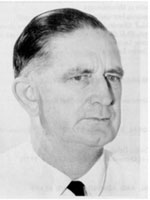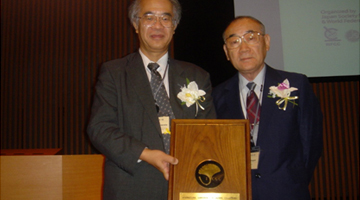The WFCC is a Multidisciplinary Commission of the International Union of Biological Sciences (IUBS) and a Federation within the International Union of Microbiological Societies (IUMS). The WFCC is concerned with the collection, authentication, maintenance and distribution of cultures of microorganisms and cultured cells. Its aim is to promote and support the establishment of culture collections and related services, to provide liaison and set up an information network between the collections and their users, to organise workshops and conferences, publications and newsletters and work to ensure the long-term perpetuation of important collections.
The Federation has an Executive Board and works through a series of committees. For more information on its structure, please refer to the WFCC statutes and by-laws.
-
- 1962
- The formation of Section on Culture Collections (SCC) was approved by the International Association of Microbiological Societies.
-
- 1966
-
Paris meeting on culture collections requested by Japan Federation for Culture Collections under the auspices of United Nations Educational, Scientific and Cultural Organization (UNESCO).
It soon became apparent that very little could be done at the international level until the location, the list of personnel and the list of the contents of the various collections of the world were obtained. The SCC agreed to undertake a survey with the aim of preparing a World Directory of Collections of Cultures of Microorganisms. It was decided to attempt to include all collections, regardless of size, from all parts of the world: to cover interesting, unique, important strains in small collections; to capture status of microbiological science in countries.
-
- 1967
- Dr. S. Martin of the National Research Council of Canada undertook the initial survey sponsored by the Council and UNESCO. SCC was reorganized as the World Federation for Culture Collections (WFCC).
-
- 1970
-
The WFCC was formed from the International Association of Microbiological Societies (IAMS) Section on Culture Collections in 1970 following several separate initiatives and international meetings on the need for such an umbrella organisation as described in the attachment.
V.B.D Skerman was Chairman of the IAMS Section on Culture Collections from 1962 to 1970. In a meeting at the International Congress for Microbiology in Mexico City in 1970, the IAMS Section on Culture Collections was dissolved and the WFCC was established with Prof. S. Martin the first WFCC President, Prof. S. Lapage, the Secretary and Prof. V.B.D. Skerman, the Treasurer. After the separation of the IAMS and the formation of the IUMS, the WFCC has had dual affiliations with both IUMS and IUBS as described in various WFCC documents.
1970-onwards Presidents of the WFCC
- 2017-2020 = D.I. Kurtböke, Australia
- 2010-2017 = P. Desmeth, Belgium
- 2004 - 2010 = D. Smith, UK
- 2000 - 2004 = J. Swings, Belgium
- 1996-2000 = V. Canhos, Brazil
- 1992-1996 = L. Sly, Australia
- 1984 - 1992 = B.E. Kirsop, UK
- 1981 - 1984 = D. Claus, Germany
- 976 - 1981 = S.P. Lapage, UK/T. Hasegawa, Japan
- 1970 – 1976 = S.M. Martin, Canada
-
- 1972
-
Prof. V.B.D. Skerman (Department of Microbiology, University of Queensland) became the first director of World Data Centre for Microorganisms (WDCM) continued the survey sponsored by UNESCO, the World Health Organization (WH) the Commonwealth Scientific and Industrial Research Organization (CSIRO) and the University. The first edition of the World Directory was published by John Wiley and Sons, Inc. New York.
Taxonomic Note: V.B.D. Skerman (1921-1993), a Reforming Force in Bacterial Systematics and Nomenclature (from: L. I. Sly, 1995 (IJSB 45(2):412-413)

Professor Victor Bruce Darlington Skerman (University of Queensland)
Professor V. B. D. Skerman made major contributions to the reform of bacterial systematics which are now in place and appreciated. He was the catalyst and a driving force for a series of reforms which led to the clarification of bacterial nomenclature. He reorganized the International Committee on Systematic Bacteriology and the Judicial Commission by persuading the members to accept and develop the statutes that govern their operations and persuaded them to adopt a new starting date for bacterial nomenclature. The resulting revision of the International Code of Nomenclature of Bacteria and the publication of the Approved Lists of Bacterial Names under his direction leave a legacy of procedures for the orderly progress of bacterial taxonomy and nomenclature.
-
- 1973
- WFCC was admitted as an Interdisciplinary Commission of the International Union of Biological Sciences (IUBS).
-
- 1975
-
1972-75
Financial support from outside sources ceased with the publication of the World Directory
-
- 1978
- International Cell Research Organization recommended the publication of revised edition of the World Directory.The revision was again financed from UNESCO, UNEP and the University of Queensland. The 2nd edition of the World Directory was published.
-
- 1984
- WDCM became affiliated with WFCC in 1984 at ICCC-5 in Bangkok, Thailand.
-
- 1986
-
The WFCC relocated the data centre to the Institute of Physical and Chemical Research (RIKEN) Japan after an open competition to host the data centre (in 1986), when Prof. V.B.D Skerman retired. The WDCM hosted at RIKEN was initially headed by Prof. Kazuo Komagata and later (in 1987) by Prof. Hideaki Sugawara. The WDCM at RIKEN made the World Directory database open to the public via a Packet Switching System and then via the Internet using a Gopher system and then a Web site. In April 1997, the WDCM moved from RIKEN to the National Institute of Genetics (NIG) after agreement among WFCC, RIKEN and the NIG. When Prof. Hideaki Sugawara moved to the Center for Information Biology and DNA Data Bank of Japan, NIG. WDCM at NIG dropped the Gopher service and concentrated on providing web-based services.
Relocation of the WDCM from Australia to Japan, 1986

WDCM Steering Committee Meeting, 1987

Prof. Kazuo Komagata瑞宝中綬章(Order of the Sacred Treasure)
Prof. Kazuo Komagata
The Van Niel International Prize
Duke of Edinburgh Prize, The Award is for his achievement of "Contribution to Microbial Taxonomic Research and Culture Collection in Japan and an International Network
Comments from Prof. Kazuo Komagata:
I have worked for "the basis of basis" - microbial taxonomy and culture collection. Research and enterprise in this field can never be carried out without cooperation of relevant persons. Thus, I believe this award of prize is not only an honor for me personally but also something to breed pride and confidence in microbial taxonomists and staff of culture collections.
-
- 2010
-
Relocation of the WDCM from Japan to China, 2010
WDCM was again transferred to Institute of Microbiology, Chinese Academy of Sciences (IMCAS) in 2010. The inauguration Ceremony of WFCC-MIRCEN WDCM and the First WDCM Seminar were held on May 17, 2011 in Beijing. Institute of Microbiology, Chinese Academy of Sciences (IMCAS) launched the WFCC (World Federation for Culture Collection) -MIRCEN (Microbial Resources Centres) World Data Center for Microorganisms (WDCM). Prof. SUGAWARA, officially transferred the host of WDCM to IMCAS and Dr Juncai Ma became the new director of the WDCM.
-
- 2011
-
WDCM 2011-onwards
WDCM is a vehicle for networking 726 microbial resource centres of diverse types of microorganisms in over 75 developed and developing countries in Culture Collections Information Worldwide database (CCINFO). It also serves as an information resource for the customers of the microbial resource centres. From 2012 onwards WDCM started the initiative to construct an effective information environment called Global Catalogue of Microorganisms (GCM) which provided database management system to culture collections and collect strain catalogue information to form an integrated database. Currently, GCM contains information of over 390,365 strains, which includes 48,335 bacterial, fungal and archaea species from 112 collections in 43 countries and regions.
-
ICCC Conferences
1. Tokyo, Japan, 1968; 2. Sao Paulo, Brazil, 1973; 3. Bombay, India, 1976; 4. Brno, Czech Republic, 1981; 5. Bangkok, Thailand, 1984; 6. Maryland, USA, 1988; 7. Beijing, China, 1992; 8. Veldhoven, The Netherlands, 1996; 9. Brisbane, Australia, 2000; 10. Tsukuba, Japan 2004; 11. Goslar, Germany, 2007; 12. Florianopolis, Brazil, 2010; 13. Beijing, China, 2013; 14. Singapore, 2017.

Prof. Makoto M. Watanabe (left) the former vice-president of WFCC and the chair of the local organizing committee of ICCC10 (2004) with Prof. Kazuo Komagata (right), the honorary life time member of WFCC and the former director of the WDCM (at RIKEN) holding the memorial plaque of the ICCC conferences.
-
Resource
1] Lapage, S. P. (1972). World Federation for Culture Collections Xth International Congress for Microbiology. International Journal of Systematic and Evolutionary Microbiology, 22(4), 404-405.
2] World Federation for Culture Collections Statutes (1972) International Journal of Systematic and Evolutionary Microbiology, 22(4), 407-409.
3] Martin, S. M., & Skerman, V. B. D. (1972). World directory of collections of cultures of microorganisms. John Wiley & Sons; New York & London.
4] Komagata, K. (2004). Milestone in Japanese culture collections. In the Proceedings of the 10th International Congress on Culture Collections, Tsukuba, Japan, 2004 (Watanabe, M.M., Suzuki, K. and Seki, T., Eds), pp. 9-16.
Further useful microbiological sites on the Internet.
| WFCC Task Forces and Activities | WFCC Bylaws | Microbiological sites |
| WFCC Statutes | The Endangered Collection Task Group (ECTG) |

